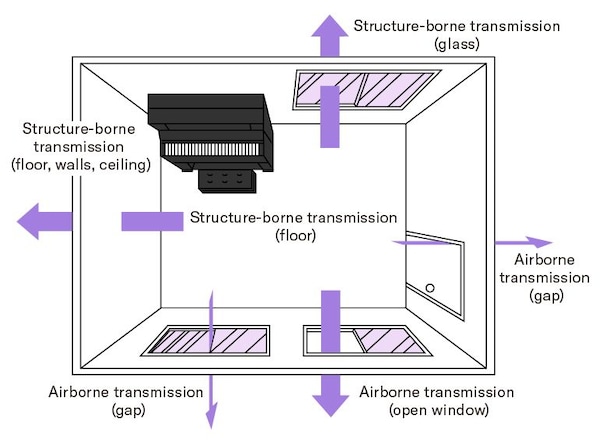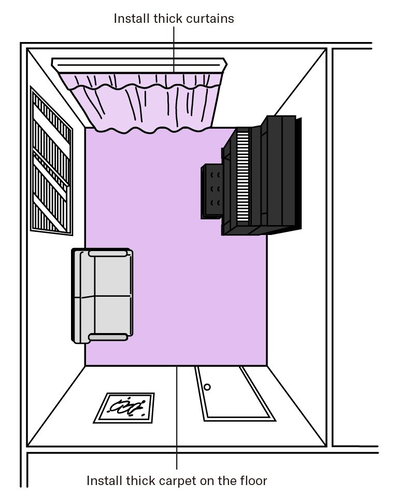Tips for Soundproofing
Consideration for sound
We are surrounded by an enormous variety of sounds in our everyday lives. How we hear these sounds is dramatically affected by the surroundings and by the state of the listener. Understanding the way that sound is transmitted to the surrounding area is the first step to enjoying beautiful piano sound.
How sound is transmitted

Categorizing sound by how it is transmitted
There are two ways that sound is transmitted.
Airborne sound: Sound that spreads from the piano through the air, passing through gaps in doors and open windows, etc.
Structure-borne sound: Vibrations that are transmitted from the piano through its casters to the floor and walls, and then radiated as sound
Taking your neighbors into consideration, it is important to be careful of airborne sound in well-ventilated houses, and of structure-borne sound in collective housing such as apartments and condominiums, which are highly sealed.
Upright pianos transmit sound to the rear, while grand pianos transmit it upwards and downwards
Different piano types exhibit different characteristics in the ways that sound is transmitted.
・ Upright pianos are notable for the loud volume of the sound transmitted to the air and walls from their rear surface.
・ Grand pianos are characteristically loud in the upward and downward directions.
Sound transmission from an upright piano
Sound transmission from a grand piano
Specific tips for soundproofing and sound insulation
Install your piano
・ In a location that is not in direct contact with an exterior wall
・ As far away as possible, taking neighbors into consideration
Specific hints and tips

・ Close windows and storm shutters
・ Use heavy or double-layered curtains
・ Use a sound muffling mechanism
・ Attach a sound insulating board to the rear of an upright piano, or to the underside of a grand piano
・ Install thick carpeting on the floor
・ Seal gaps in windows and doors
Suggestions from Yamaha
SILENT Piano TM and TransAcoustic TM Piano
These unique products from Yamaha utilize a combination of digital and acoustic technologies that offer you the enjoyment of an acoustic piano without having to worry about the sound. Please refer to the product pages below for details.
Instrumentenkunde: Das Piano Inhalte
Herkunft
Aufbau
Spielen lernen
Wie das Instrument hergestellt wird
Die Wahl des richtigen Instruments
Pflege und Wartung
Wissenswertes
- Zu Mozarts Zeiten waren die weißen und schwarzen Tasten genau umgekehrt
- Hatte Mozarts Piano eine Pedalklaviatur?
- Piano mit automatischer Begleitung zu Beethovens Zeiten
- Die Pianos, die der große Meister Swjatoslaw Richter liebte
- Das perfekte Material für Piano Gussrahmen ist auch ideal für Motorradmotoren
- Der Resonanzboden des Pianos stoppt auch Vibrationen
- Warum kann ein Piano nicht mehr als 88 Tasten haben?
- Warum fühlen sich die Tasten eines Flügels schwergängiger an als die eines Klaviers?




